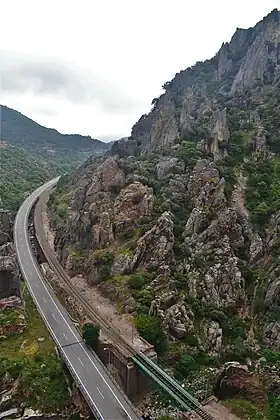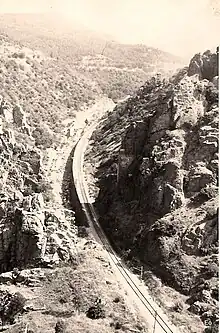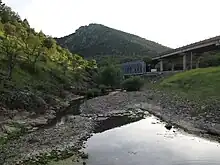Despeñaperros Pass
The Despeñaperros Pass has been a strategic location for communications between Andalusia and the Spanish Meseta throughout history. Both by road and rail, this pass has been crucial in facilitating the transit of people and goods between the two regions. With its rugged relief, full of canyons and gorges, impressive engineering works of the history of transport in Spain have been carried out over time.
| Despeñaperros Pass | |
|---|---|
| Spanish: Paso de Despeñaperros | |
 Former part of the road and the current Madrid-Cádiz railway line | |
| Elevation | 663 m (2,175 ft) |
| Length | 9 kilometres (5.6 mi) |
| Traversed by | E-5 A-4
N-IV Alcázar de San Juan–Cádiz railway |
| Location | Santa Elena, Andalusia - Venta de Cárdenas, Castilla-La Mancha |
| Range | Sierra Morena |
| Coordinates | 38°23′10″N 3°30′25″W |
 Location in Spain | |
Its rugged geography and narrow passes have required the construction of bridges, tunnels and other engineering works to overcome the natural obstacles. These infrastructures have witnessed the evolution of transport and have facilitated the economic and social development of the region.
Today, the Despeñaperros pass continues to be a vital artery for vehicle and train traffic.
The chronological evolution of the mountain pass can be summarized as follows: Iturbide's attempt to create the road, which was finally completed by Lemaur; the adaptation to the CNFE[note 1]; the successive improvements to the N-IV road; the doubling of the roadway in the 1980s and finally the opening of the new A-4 highway.
By other way, the railway line maintain the same track (except minor fixes) since was built.
History
%22_(19314483744).jpg.webp)
The main routes of communication with the exterior of the present-day territory of Andalusia over time were the Tartessian way from Cadiz and Seville to the ports of the north of the peninsula, later known as the Silver Way (Vía de la Plata), and the Roman way between Cadiz and Rome, known as Via Augusta. The former went up northwards along the entire western part of the peninsula and the latter road found the Mediterranean coast after crossing the Guadalquivir valley from west to east.[1]
Before the Despeñaperros Pass was opened up, the routes to Andalusia from the Meseta forked out from Toledo either to the southwest, towards the valley of the Alcudia and the Guadalquivir or, for travellers headed for Jaén or Granada, southeast towards the Muradal Pass in the Sierra Morena, near Despeñaperros.[2]
Before the construction of this road, the previous mountain passes were, during the Middle Ages, the "Del Rey", "Muladar" and "De Olavide" passes, most of them to the west of the current Despeñaperros pass. The communication between Andalusia and La Mancha went back to Toledo through Brazatortas, Puertollano and Ciudad Real among others.[3]
With the establishment of the court and capital in Madrid, it was of vital importance for the trade of goods and people between the capital and the ports bound for the Americas, first from Seville and then Cadiz, from 1717.[note 2]
The influence in Madrid was that with the opening of this passage from the entrance to Andalusia, the roads to Toledo were abandoned, and the new road became more important than the old one. The road from Madrid to Andalusia, from then on, would take the same route to Toledo, but turning south once past the Puente de Toledo.
With the motorisation of the population, the road underwent modifications to adapt it to the new vehicles and today it is adapted to the high volumes of traffic that are recorded year after year, especially during the summer months.[note 3]
Road Pass
Lemaur pass

Wih the transfer of the port of the Americas from Seville to Cádiz, the goods arriving from the Americas via Cádiz or vice-versa, had to go over El Rey Pass, which was a slow and hard slope through Sierra Morena from Andalusia to Castille. The weight of the freight through this pass, added to the slopes, made it exhausting for the horses. The transportation on this Madrid-Cádiz route had to be fluid, as delays would have repercussions on the transportations of the ships towards the Americas. The 1720 Postal Agreement had included Cádiz as the true point of the contact with the Americas' at the expense of Seville. And by the following year, 1761, the first rules and regulations for roads and trails for carts had been published.[4]
Pablo de Olavide's New Settlements plan commenced in 1767,[note 4] in Sierra Morena. The plan was devised to support the cargo freight and stagecoaches, serve as replacement points for horses and rest of travelers. Once achieved, several previously deserted areas, that had become unsafe areas for the cargo and passengers attacked by brigands became populated.[1]
"Se considera el único que se puede sacar mayor provecho, por ser más corto, más llano and más permanente entre Santa Elena a Santa Cruz".[5]
It is considered the only route that is better suited, as it is shorter, flatter and the most permanent one between Santa Elena and Santa Cruz.
— J. Iturbide
CNFE itinerary

The road was improved for the new motorized transport, by modifying bends and improving cants or cambers.[4]
N-IV Road

The adaptation of the old road (Route IX) for the new N-IV consisted of improving curves and widening the roadway.
Then, in the 1950s, the biggest work was undertaken at that time: the opening of the Niebla tunnel, in the ravine of the same name and the elimination of the dangerous curve that follows it.
In 1984, the road was doubled in length. A new carriageway was built, but the old one was used halfway in each direction.[note 5] That is to say, from Santa Elena to the middle, the old carriageway was in the direction of Madrid and from the middle to Venta de Cárdenas it was for the direction of Cádiz.[4][6]
Current A-4 motorway
.jpg.webp)
With the growing increase in traffic through the pass, as early as 1993, work began to find a solution to the problem of Despeñaperros, as the original project only contemplated the solution towards Madrid, and with two lanes. Inaugurated in 2012, the current project has three lanes in both directions. Multiple tunnels and viaducts bridge the large differences in level between the Meseta and the Andalusian plain.[7]
|
Towards Cádiz:
|
Towards Madrid:
|
With a total investment of 190 million euros, of which 8 million were earmarked for environmental conservation, given the high ecological value of the natural park, habitat of Iberian lynxes.[10][11]

Railway pass

In the 19th century, an important infrastructure was built in the Despeñaperros Pass: the railway crossing. The Madrid-Cádiz railway line (General Line of Andalusia), fully inaugurated in 1865, crossed the Despeñaperros Pass, which was a milestone in the development of transport in the region. The railway route included the construction of several tunnels and bridges to overcome the unevenness and allow the train to pass between the gorge and the river excavated by the ravine. [12][13]

.jpg.webp)
The construction of the penetration line into Andalusian lands dates back to 1859, when the Madrid-Zaragoza-Alicante Railway Company (MZA) started its expansion towards Andalusia. In April of the same year it won the concession to build a railway that would be from Alcázar de San Juan to Ciudad Real and began construction work, which was completed in March 1861. While these works were taking place, in October 1860, MZA was awarded the state concession for the construction of a railway line between Manzanares and Córdoba.[12][14]
This new railway, with a planned length of 243.6 km,[15] would cross the Despeñaperros pass and the Guadalquivir valley. Due to the orographic difficulties encountered by the construction company, the works on the Manzanares-Córdoba section were not completed until September 1866, when the line was opened to traffic.[16]
As for the tunnels, the railway line crosses the Despeñaperros gorge by means of a series of tunnels that take advantage of the river's furrow. These tunnels make it possible to avoid topographical difficulties and guarantee the continuity of the railway line. Some of the most notable tunnels are the Despeñaperros Tunnel, the Vadollano Station and the San Bartolomé Tunnel.
The Despeñaperros Tunnel, with a length of approximately 2.5 kilometres, is one of the longest tunnels in the railway line. As the train enters the tunnel at the transition between the province of Jaén and Ciudad Real.
The siding at Las Correderas, the bridges over the Arroyo de Despeñaperros, the Santa Elena Tunnel, Despeñaperros Bridge No. 5, the Calancha Tunnel, the long metal bridge at Las Guarizas, the Vilches Tunnel and the viaduct at Vadollano station are significant landmarks on the railway route through the Despeñaperros Pass.
The Despeñaperros Pass was an important link between central and southern Spain for many years, facilitating the transport of passengers and large quantities of goods from the southern ports to the peninsular interior. Nowadays, the New Railway Access to Andalusia(NAFA) absorbs a large amount of Andalusian railway traffic, most of it being high-speed trains.
As of today, the trains that run through the pass are the Madrid-Jaén, Madrid-Almería and Cádiz-Barcelona trains, as well as various freight trains.
Notes
- Circuito Nacional de Firmes Especiales, literally National circuit of special road surfaces
- In fact, the idea for making the road came following the transfer of the Casa de Contratación, the Crown's agency for the Spanish Empire, from Seville to Cádiz in 1717.
- Maghrebi migrants cross the Strait of Gibraltar by ferry to return to their countries of origin
- The New Settlements (Nuevas Poblaciones) plan to populate deserted areas on the way to Cádiz from Madrid. The villages founded were in the part of Sierra Morena (just this area) and in Andalucía (among Seville and Córdoba)
- The system developed in this improvement of the road was used Saltire shape for two roads: The old road was used for the road from Ventas de Cárdenas towards Cádiz at Las Correderas, that in this point changes to new road and vice-versa towards Madrid.
References
- "Atlas de Andalucía" (PDF). Junta de Andalucía.
- "Caminos en el siglo XVIII - Atlas histórico de Andalucía" (PDF). Junta de Andalucía. Retrieved 23 August 2023.
- Corchado Soriano, Manuel (1967). Pasos Naturales y antiguos entre Jaén y La Mancha.
- El camino de Andalucía itinerarios históricos entre la Meseta y el Valle del Guadalquivir. Ministerio de Fomento. 1993.
- AHN, "Consejos" leg.761, exp.9, doc. March 22th 1777
- Video of Construcciones Dragados on the road duplication work.
- Costas, Javier (28 September 2011). "El paso de Despeñaperros se moderniza (al fin)". Motorpasión (in Spanish). Retrieved 24 August 2023.
- Rodríguez López, Beatriz (December 2009). "A buen paso" (PDF). Ministerio de Fomento (in Spanish): 2-4. Retrieved 24 August 2023.
- Díaz Pardo, Francisco (2011). "Despeñaperros y el Ferrocarril (I)" (in Spanish). Geotren. Retrieved 13 June 2023.
- Fccco (2013). FCC construction company's video on the Despeñaperros new crossing site (YouTube) (in Spanish). Retrieved 24 August 2023.
- "Fomento de Construcciones y Contratas SA : Two sections of the Despeñaperros pass on Spain's Southern Highway, built by FCC, are opened to traffic". MasketScreener. 26 September 2011. Retrieved 24 August 2023.
- Peris Torner, Juan. "Manzanares á Córdoba". Ferrocarriles de España (in Spanish). Retrieved 2 October 2023.
- "Despeñaperros, historia y trenes". Diario de Jaén. 10 April 2019. Retrieved 2 October 2023.
- Wais, Francisco. Historia de los ferrocarriles españoles. Editora Nacional. p. 184. ISBN 9788427611610.
- López-Morell, Miguel A. (2005). La Casa Rothschild en España. p. 168.
- Rodríguez Lázaro, Francisco Javier. Los primeros ferrocarriles. Akal. p. 28. ISBN 8446014874.
Bibliography
- Centro de Publicaciones (1993). El camino de Andalucía itinerarios históricos entre la Meseta y el Valle del Guadalquivir. Madrid: Ministerio de Obras Públicas, Transportes y Medio Ambiente. ISBN: 84-7433-935-9
- Ford, Richard (1845). A Handbook for Travellers in Spain. London: Turner.
- Rodríguez Lázaro, F. J.; Coronado, J. M., Ruiz, R.; Vega, J. G. de la (2007). Análisis y valoración del patrimonio histórico de las carreteras españolas 1748-1936. Madrid: Ministerio de Fomento, CEHOPU.